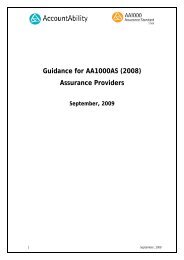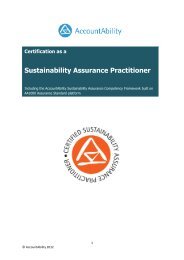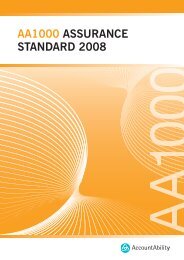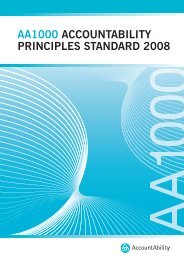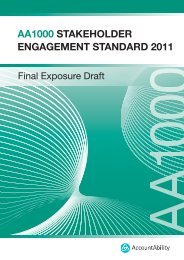The Stakeholder Engagement Manual Volume 2 - AccountAbility
The Stakeholder Engagement Manual Volume 2 - AccountAbility
The Stakeholder Engagement Manual Volume 2 - AccountAbility
You also want an ePaper? Increase the reach of your titles
YUMPU automatically turns print PDFs into web optimized ePapers that Google loves.
Level<br />
Remain Passive<br />
Monitor<br />
Inform<br />
Transact<br />
Consult<br />
Involve<br />
Collaborate<br />
Empower<br />
Levels of <strong>Engagement</strong> 11<br />
Goal<br />
No goal.<br />
No engagement.<br />
Monitor stakeholders’<br />
views.<br />
Inform or educate<br />
stakeholders.<br />
Work together in a<br />
contractual relationship<br />
where one partner<br />
directs the objectives and<br />
provides funding.<br />
Gain information<br />
and feedback from<br />
stakeholders to inform<br />
decisions made<br />
internally.<br />
Work directly with<br />
stakeholders to ensure<br />
that their concerns are<br />
fully understood and<br />
considered in decision<br />
making.<br />
Partner with or<br />
convene a network<br />
of stakeholders to<br />
develop mutually<br />
agreed solutions and<br />
joint plan of action.<br />
Delegate decisionmaking<br />
on a particular<br />
issue to stakeholders.<br />
Communication<br />
No active communication<br />
One-way: stakeholder to<br />
company.<br />
One-way: company to<br />
stakeholder, there is no<br />
invitation to reply.<br />
Limited two-way: setting<br />
and monitoring<br />
performance according to<br />
terms of contract.<br />
Limited two-way: company<br />
asks questions and the<br />
stakeholders answer.<br />
Two-way, or multi-way<br />
between company and<br />
stakeholders. Learning<br />
takes place on both<br />
sides. <strong>Stakeholder</strong>s and<br />
company take action<br />
individually.<br />
Two-way, or multi-way<br />
between company/ies and<br />
stakeholders. Learning,<br />
negotiation, and decision<br />
making on both sides.<br />
<strong>Stakeholder</strong>s work<br />
together to take action.<br />
New organisational<br />
forms of accountability:<br />
stakeholders have formal<br />
role in governance of an<br />
organisation or decisions<br />
are delegated out to<br />
stakeholders.<br />
Nature of relationship<br />
No relationship<br />
No relationship<br />
Short or long term relationship<br />
with stakeholders.<br />
"We will keep you informed."<br />
Relationship terms set by<br />
contractual agreement.<br />
“We will do what we said we<br />
would” or “we will provide the<br />
resources to enable you to do<br />
what we agree”.<br />
Short- or long-term involvement.<br />
"We will keep you informed,<br />
listen to your concerns, consider<br />
your insights, and provide<br />
feedback on our decision."<br />
May be one-off or longer-term<br />
engagement. "We will work<br />
with you to ensure that your<br />
concerns are understood, to<br />
develop alternative proposals<br />
and to provide feedback<br />
about how stakeholders views<br />
infl uenced the decision making<br />
process”.<br />
Long- term. "We will look to<br />
you for direct advice and<br />
participation in fi nding and<br />
implementing solutions to<br />
shared challenges.”<br />
Long-term."We will implement<br />
what you<br />
decide.”<br />
11 See also the complementary Figure 1.3 in <strong>Volume</strong> 1: “<strong>The</strong> Guide to Practitioners’ Perspectives on <strong>Stakeholder</strong> <strong>Engagement</strong>”, p. 14<br />
STAGE 4<br />
<strong>Engagement</strong> Approaches<br />
<strong>Stakeholder</strong> concern expressed<br />
through protest, letters, media, web-<br />
sites etc., or pressure on regulatory<br />
bodies and other advocacy efforts.<br />
Media and internet tracking.<br />
Second-hand reports from other<br />
stakeholders possibly via targeted<br />
interviews.<br />
Bulletins and letters. Brochures,<br />
reports and websites. Speeches,<br />
conference and public presentations.<br />
Open houses and facility tours. Road<br />
shows and public displays. Press<br />
releases, press conferences, media<br />
advertising, lobbying.<br />
‘Public Private partnerships’<br />
and Private Finance Initiatives,<br />
Grant-making, cause related<br />
marketing.<br />
Surveys. Focus Groups. Workplace<br />
assessments. One-to-one meetings.<br />
Public meetings and workshops.<br />
Standing stakeholder advisory<br />
forums. On-line feedback and<br />
discussion.<br />
Multi-stakeholder forums.<br />
Advisory panels. Consensus<br />
building processes.<br />
Participatory decision<br />
making processes.<br />
Joint projects, voluntary<br />
two-party or multi-stakeholder<br />
Initiatives, Partnerships.<br />
Integration of <strong>Stakeholder</strong>s into<br />
Governance Structure. (eg. as<br />
members, shareholders or on<br />
particular committees etc.)<br />
THE PRACTITIONER'S HANDBOOK ON STAKEHOLDER ENGAGEMENT | 97



